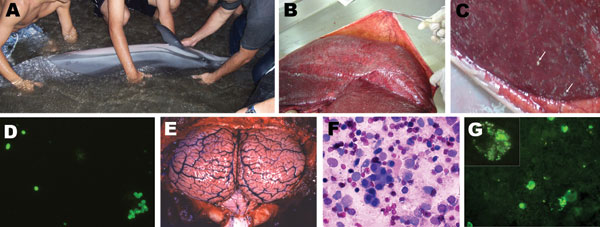
19 The authors reported that a detailed assessment of fetal BN cardiovascular status, including 2D imaging and color flow mapping of the heart and great arteries as well as pulsed Doppler evaluation of the umbilical artery and vein, could be obtained between 8 and 9 months of gestation. Fetal echocardiography was recently described in BN by Sklansky et al.

Furthermore, this is the first report that forecasts the cephalic presentation of the calf at birth, according to its position within the uterus. For the first time, the sonographic findings of the bottlenose dolphin organogenesis and their correlation with the stage of pregnancy are described. A total of 192 ultrasound exams were included in the study.

DOLPHIN FETUS SERIAL
From 2009 to 2019, serial ultrasonographic exams of 11 healthy bottlenose dolphin females kept under human care were evaluated over the course of 16 pregnancies. The aim of this study is to provide additional relevant data on feto-maternal ultrasonographic monitoring in bottlenose dolphin (Tursiops truncatus) species, for both the clinicians and for in situ population studies. Reproductive success is an important aspect of dolphin population health, as it is an indicator of the future trajectory of the population. Ultrasonography plays an important role in modern-day cetacean preventative medicine because it is a non-invasive technique, it is safe for both patient and operator, and it can be performed routinely using trained responses that enable medical procedures. Ultrasonography is widely used in veterinary medicine for the diagnosis of pregnancy, and can also be used to monitor abnormal pregnancies, embryonic resorption, or fetal abortion. Fetal echocardiography, particularly between 8 and 9 mo gestation, can provide a safe and detailed assessment of the cardiovascular status of the fetal bottlenose dolphin. Pulsed Doppler techniques demonstrated normal umbilical arterial and venous waveforms, and color flow mapping demonstrated absence of significant valvar regurgitation. With the use of published human fetal echocardiographic findings for comparison, fetal echocardiography demonstrated normal structure and function of the heart and great arteries, including the pulmonary veins, inferior vena cava, right and left atria, foramen ovale, tricuspid and mitral valves, right and left ventricles, ventricular septum, pulmonary and aortic valves, main pulmonary artery and ascending aorta, and ductus arteriosus. Thorough evaluations of the fetal dolphins' cardiovascular status were performed, with the greatest resolution between 8 and 9 mo gestation. Fetal echocardiography included two-dimensional imaging and color flow mapping of the heart and great arteries, as well as pulsed Doppler evaluation of the umbilical artery and vein. Multiple transducers, probes, and maternal dolphin positions were used to optimize image quality.
DOLPHIN FETUS PORTABLE
Evaluations were performed without sedation, using conventional, portable ultrasound systems.

Eight singleton fetal bottlenose dolphins (Tursiops truncatus) were evaluated, each between 6 and 11 mo gestation six fetuses underwent two fetal echocardiographic evaluations each, four at 3-mo intervals, and two at 0.5-mo intervals. Because the application of fetal echocardiography to cetaceans could have both clinical and academic importance, an approach to evaluating the fetal dolphin's cardiovascular status was developed with conventional, fetal echocardiographic techniques developed in humans. However, because of logistic, anatomic, and behavioral challenges, detailed fetal echocardiographic evaluation of marine mammals has not been previously described. In humans, fetal echocardiography represents the most important tool for the assessment of the cardiovascular well-being of the fetus.


 0 kommentar(er)
0 kommentar(er)
